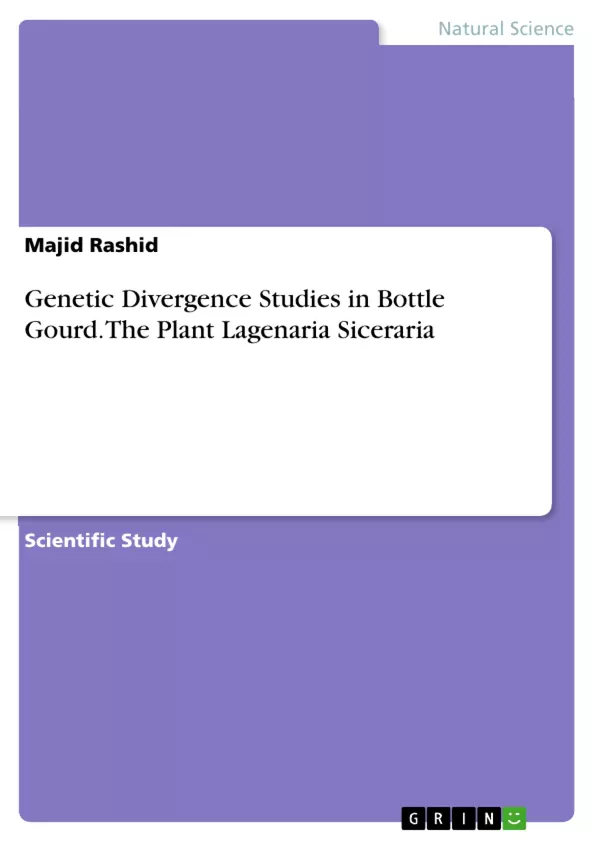The experiment was laid out in randomized complete block design (RCBD) with three replications. Thirty genotypes were evaluated for various quantitative and quality traits. Analysis of variance revealed significant differences among genotypes for all the traits. The maximum fruit yield plant-1 was recorded in Shalimar improved (7.57 kg) followed by SH-BG-72 (7.30 kg), SH-BG-17 (7.28 kg) and minimum in SH-BG-53 (4.32 kg). The estimates of phenotypic coefficient of variance were slightly higher than the corresponding genotypic coefficient of variance for all the characters studied indicating the little influence of environment in the expression of these traits.
The highest phenotypic and genotypic coefficients of variation were observed for fruit diameter (35.65 and 34.62) followed by total chlorophyll (30.08 and 20.02) and fruit length (23.70 and 23.44). High heritability coupled with high genetic gain was recorded for fruit length (0.97 and 47.74), fruit diameter (0.94 and 71.73), total sugars (0.74 and 24.05) and dry matter content (0.84 and 25.42) indicating that the heritability is most likely due to additive gene effects and thus the chances of fixing by selection are more. Fruit yield plant-1 was positively associated with traits like node number at which first male flower appeared, node number at which first female flower appeared, number of days to anthesis of first female flower, fruit diameter, dry matter content and total sugars.
Moreover the traits like days to last fruit harvest and number of fruits plant-1 showed significant positive genotypic correlation with fruit yield plant-1 indicating that direct selection of these traits will be effective. Path coefficient analysis revealed appreciable amount of direct positive effects of component traits like node number at which first male flower appeared, days to anthesis of first female flower, days to last fruit harvest, number of fruits plant-1, fruit weight plant-1 and total sugars on fruit yield plant-1. D2 statistics grouped thirty genotypes of bottle gourd into three clusters. Cluster I had maximum number of genotypes (25) followed by cluster II (4) and cluster III (1).
Table of Contents
- ABSTRACT
- INTRODUCTION
- REVIEW OF LITERATURE
- MATERIALS AND METHODS
- Experimental Material
- Experimental Design
- Data Collection
- Statistical Analysis
- RESULTS AND DISCUSSION
- Genetic Variability
- Correlation Studies
- Path Coefficient Analysis
- Genetic Divergence
- SUMMARY AND CONCLUSIONS
- REFERENCES
Objectives and Key Themes
This thesis aims to assess the genetic divergence among thirty genotypes of bottle gourd [Lagenaria siceraria (Molina) Standl.] based on various quantitative and quality traits. The study explores the genetic variability, correlation, path coefficient, and genetic divergence to provide insights for efficient breeding programs.
- Genetic variability and heritability of key traits in bottle gourd
- Correlation and path coefficient analysis to identify traits associated with fruit yield
- Genetic divergence among genotypes using Mahalanobis D² statistics
- Identification of genotypes with high per se performance and potential for hybridization
- Contributions of individual traits to genetic divergence and their implications for breeding strategies
Chapter Summaries
- Introduction: This chapter provides a background on the importance of bottle gourd as a vegetable crop, highlighting its nutritional value and economic significance. It outlines the need for genetic improvement to enhance yield and quality traits.
- Review of Literature: This chapter presents a comprehensive review of existing literature on genetic diversity, variability, correlation, and path coefficient analysis in bottle gourd. It also explores previous studies on genetic divergence and its application in breeding programs.
- Materials and Methods: This chapter details the experimental material, experimental design, data collection methods, and statistical analysis used in the study. It outlines the procedures for evaluating various quantitative and quality traits of the bottle gourd genotypes.
- Results and Discussion: This chapter presents the results of the study, including analysis of variance, estimates of phenotypic and genotypic coefficients of variation, heritability, genetic gain, correlation studies, path coefficient analysis, and genetic divergence among genotypes. It discusses the implications of these findings for improving bottle gourd breeding.
Keywords
The primary focus of this thesis is on genetic divergence studies in bottle gourd, encompassing key concepts such as genetic variability, correlation, path coefficient, and genetic divergence. The study examines the relationship between various quantitative and quality traits and their contribution to overall yield and quality. Key terms include heritability, genetic gain, Mahalanobis D² statistics, and cluster analysis. The findings provide insights into breeding strategies for improving bottle gourd varieties.
- Arbeit zitieren
- Majid Rashid (Autor:in), 2020, Genetic Divergence Studies in Bottle Gourd. The Plant Lagenaria Siceraria, München, GRIN Verlag, https://www.grin.com/document/915342



